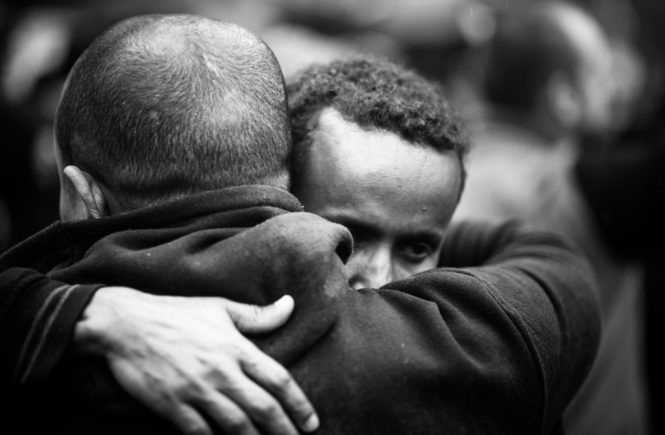We are beginning the sixth chapter of the Gospel of John. The Gospel of John is one that’s full of signs, meanings, symbolism, and high theology. But over the next several Sundays, the main theme is going to be how He sees Himself. If we want to learn how to relate to Jesus, we need to ask the question: who does Jesus say that He is? In John, Jesus gives seven “I AM” statements to illustrate who He is. You know many of them already:
I am the Good Shepherd.
I am the Light.
I am the Way.
Today we hear another one: I am the Bread of Life.
Pay attention to the words: “I AM.” In the Old Testament, there was one Being who would use those words, and that was God Himself. You might remember Moses inquiring at the burning bush: Who shall I say sent me? What is His name? to which God responds: Tell them that I AM sent me to you. First century Jewish men and women paying attention to Jesus’s frequent use of I AM would certainly have remembered Moses’ encounter with Yahweh.
I AM the bread of life
In last week’s Gospel, Jesus multiplied the bread and fish, and today in the first reading, we read how this happened first in the Old Testament, when God gave them bread from heaven, the manna. Jesus reminds them that it wasn’t Moses who gave them the bread but “My Father in heaven.” Do you see what Jesus just did there? First, He feeds them bread and then He tells them that in the Old Testament, it was God himself who gave them bread. So, what does that make Jesus?
After feeding the people bread, he crosses the lake, like Moses crossed the Red Sea. Jesus makes His way to the other side, and there are two groups of people waiting for Him. The first group – those people who were fed by bread moments ago but are now hungry again- and the second – the people who heard what He had done and want to witness the miracle.
Jesus introduces to them this idea of Himself as the new bread: I AM the bread of life. The people ask, “What must we do to get that bread?”—thinking still only of the literal bread that Jesus just fed them. Jesus responds:
Whoever comes to me will never hunger.
Whoever believes in me will never thirst. I am the bread of life.
Faith without works is dead
Pay attention to the verbs that Jesus uses: Whoever comes to me and believes in me. He didn’t just say “whoever believes in me with all their heart.” That faith needs to be active. That belief must inform me in some way, it must compel me to move, to act, to come; and I must manifest that in my actions.
St. Paul puts it this way in the second reading: “You should put away the old self of your former way of life, corrupted through deceitful desires and renewed in the spirit of your minds and put on the new self created in God’s way in righteousness and holiness of truth.”
What could our old self be? What could our new self be?
In this moment, when Jesus is speaking of “the bread,” the bread He refers to is not yet the Bread of the Eucharist, the Bread of the Last Supper. There is no table and no wine; but this bread begins to foreshadow and eventually leads to the Bread of His Body in the Holy Eucharist.
We see two breads in the Mass:
The Bread of the Word on the table of the Word
and
The Bread of the Eucharist on the the table of the Eucharist.
Let’s consider the first “bread” that Jesus talks about today, the bread of his Word, the bread of His Message.
Message? What Message?
What is His message? The answer is simple: He IS His message. I am the bread of life. The Messenger and the Message identify as one in the same. If Jesus is the Message, the Word of God made flesh, we cold ask, what effect can “words” have in our lives?
Let’s try an example.
Do not think of a Belgian waffle,
warm and puffy on the inside
crispy brown on the outside.
Do not think of butter melting slowly on top of it.
Do not think of sweet strawberries or fresh blueberries over the waffle.
Do not think of whipped cream or honey oozing down slowly.
Do not think of crispy bacon sizzling on the side.
Do not think about what the first bite would taste like.
Ok, enough with food!
Something happened in your mind, something probably even happened in your body! My words, the words of a man, transformed you in a way. You conceived my words in your mind, and your body reacted. Your stomach started grumbling. Your mouth probably even started watering. Well, If that is the power that human words have to transform human beings, what power could the Word of Jesus Christ have on us if we listen to them with hunger and chew on this Bread of Life?
We spoke earlier about the two breads, the bread of the Word and the bread of the Eucharist. One leads to the other, but we must begin by acknowledging the message of Christ, by listening to it, by accepting it, and by striving to live by it – probably the hardest one: believe and come.
In Stages
One of the most renowned British journalist at the end of the last century was a man named Malcolm Muggeridge, a strong social critic of the movements going on in his, especially the sexual revolution. In 1982, he wrote an article in The Times called, “Why I converted to Catholicism.” He was 80 years old when he converted, and he writes about this and an encounter with a particular person.
There are many things that called him to our Faith.
As part of his journaling work, he made a documentary on the life and work of Mother Teresa of Calcutta. He went to Calcutta, lived with her, worked with her, and he said that his conversion took place in three stages.
The first stage was horror: horror at the sights, the smells, and the sounds of the hospice. It was a state of repulsion. But he was decided to remain open.
The second stage was compassion: learning to see suffering men and women as having dignity, overcoming disgust for the sake of these men and women.
The third one was something that he had never experienced before: the awareness that the lepers and the sick before him were not pitiable, repulsive, or forlorn, but rather dear and delightful as friends, brothers, and sisters. He saw how Mother Teresa personified the message of Christ, how she embodied the Bread of Life, the Bread of the Word. He saw how this little woman was living the Message of Christ, how she was eating by her actions the Bread of the Word. That was the last straw for him to convert fully to Catholicism, at 80 years old.
Malcolm saw through Mother Teresa that the Bread of the Word leads us to the Bread of the Eucharist. He would say, “It was impossible to be with her, to listen to her, to observe what she was doing and how she was doing it without being, in some degree, converted. Her total devotion to Christ convicted her to treat, help, and love everyone, as if he were Christ Himself.”
It’s Both/And, Not Either/Or
It’s very common for people to ask priests, “Father, why is it that I cannot receive Holy Communion because of my marriage situation? Why is it that the Church pushes us away and rejects us?” It’s a tough question to respond to, but what I say is that the Church doesn’t push anyone away. We must understand that to receive Christ in sacramental Communion is to be in communion with His teachings.
To accept the Bread of the Eucharist to accept the Bread of the Word. I cannot say, I accept Jesus’s Real Presence in the Eucharist, but I reject some of His teachings. HE IS HIS MESSAGE! The Bread of the Eucharist cannot contradict the Bread of the Word. A conditioned, selective acceptance of the person I love breaks communion with them. Communion with the Eucharist is a sign of communion with the teachings of Christ.
To receive the Body of Christ while rejecting part of His message would be a contradiction. We would incapacitate ourselves to receive the Body of Christ because we’re not receiving the Bread of His Word first. To receive His Holy Body in the Eucharist would be a contradiction. We would incapacitate ourselves to receive the Body of Christ because we’re not receiving the Bread of His Message.
Jesus is the Message.
The Message is Jesus.
The way through it is not to overlook or turn a blind eye to that teaching of Jesus that make us uncomfortable, the part that I really am not willing to work on, the part that doesn’t adapt to my wants. To work through those parts of our lives that don’t conform to the Word is to lean in to the teachings of Christ and confront them in conscience in prayer and discernment, to chew on them, and come to Him: to convert and putting away our old selves. Are they easy teachings? No, we know they’re not easy! But we need to encounter our consciences with the Bread of the Word, and work through it.
Mary can show us the humility and the wisdom to believe in the teachings of Christ, the Bread of the Word, a new creation, a living Christ, something marvelous. A man, a woman that perhaps you had never been before, vested with the very image and love of Jesus Christ.




